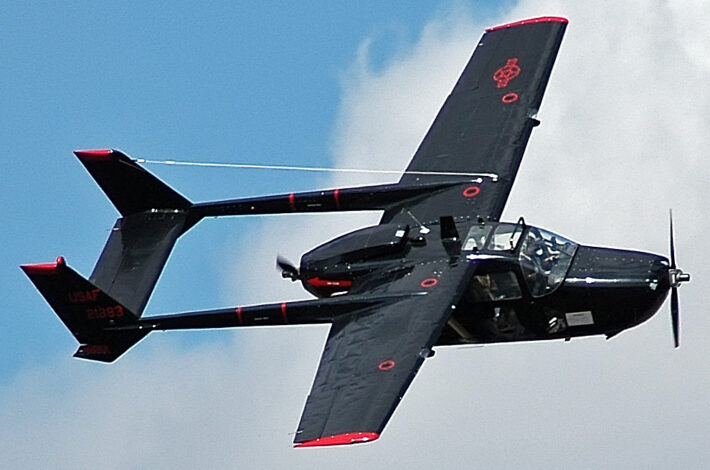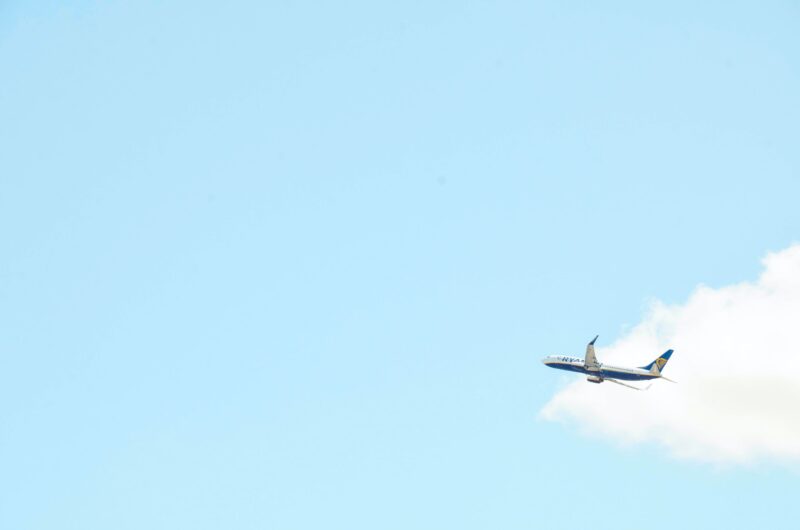
Since its debut, in 1965 the Cessna 337 Skymaster has become a favorite among aviation enthusiasts due to its one of a kind engine configuration. Interestingly the concept of this engine layout predates Cessna as evidenced by the engine placement.
The Cessna 337 showcases a push pull design with one engine functioning as a tractor at the front and another as a pusher at the back. This innovative approach aimed to provide a experience compared to traditional wing mounted engines in multi engine aircraft. Notably this layout offers an advantage by minimizing moments resulting from engine failure thereby reducing the chances of accidents during single engine operations.
Its popularity is further evident through its usage by the Flying Bulls. Nonetheless it’s important to acknowledge that this unconventional arrangement does have some limitations, including challenges with the engine during takeoff particularly, on hot days.Furthermore one must take into account the impact of maintenance and operational expenses which can be factors to consider.
Aircraft Design
The Cessna 337 Skymaster offers an opportunity to explore the fundamentals of aircraft design shedding light on the development of airplanes. Every aspect of aircraft design is carefully considered by engineers as they strive to overcome challenges and achieve success.
- In a scenario an aircraft should possess a structure, exceptional performance, easy maneuverability and cost effectiveness, in both production and operation. Each of these factors presents hurdles throughout the design process as engineers aim to strike a balance between costs and enhanced performance compared to technologies;
- The specifications of an aircraft encompass its range, speed, maximum altitude, weight, takeoff and landing capabilities among others. Mission requirements also play a role in defining the purpose of the aircraft whether it entails passenger transportation or intricate military operations;
- When an aircraft designer embarks on a project the initial phase involves design with numerous iterations. At this stage the aircraft exists as a concept without a defined shape, characterized by its intended tasks and the standards it must meet. The primary objective is to determine the necessary thrust and wing specifications, such, as the lift coefficient, through iterations before proceeding to a detailed design;
- Engineers typically employ a graph during the stages to identify the suitable design points based on factors such, as sustained turns, takeoff runs, climbs and other specific requirements. Once the optimal lift, thrust and weight restrictions are determined designers must seek configurations that align with these criteria. One vital consideration is the selection of a propulsion system that can deliver the thrust to overcome drag.
Various decisions need to be made concerning the number of engines (whether multiple) the type of propulsion (whether propeller driven or turbofan) and the placement of the engine (either pusher or tractor). Each choice carries its set of advantages and disadvantages. For example propeller driven aircraft tend to excel at altitudes while piston engines offer fuel efficiency and perform better at altitudes. Nevertheless their overall performance may be overshadowed by that of turbojet and turbofan engines. On the other hand , turboprops present a solution that performs well both at lower and higher altitudes.
When it comes to Aircraft Propeller Arrangement
When it comes to how aircraft propellersre arranged there are two choices: tractor and pusher configurations. The majority of aviation aircraft opt, for the tractor configuration, where the propellers are positioned in front of the aircraft to pull it through the air. Conversely a pusher arrangement situates the propellers at the rear propelling the aircraft forward.
Cessna 337 Configuration and Specifications
The Cessna 337 Skymasters design choices that capture the attention are its wing, propellers and tail. The positioning of the wing is a decision taking into account factors such, as accessibility, field of view stability, control and aerodynamic drag. The high wing design of the Cessna 337 Skymaster provides visibility making it ideal for observation purposes while also contributing to its stability.
Nevertheless the remarkable feature of the Cessna 337 lies in its push pull configuration. This distinctive design incorporates two engines—one acting as a tractor and the other as a pusher. This arrangement offers the advantage of centerline thrust. Combines the merits and drawbacks of both layouts.
Unlike engine configurations, where there exists a gap between the center of gravity and the engine mounted on the wing, the design of the Cessna 337 eliminates the yaw moment resulting from an engine failure. Consequently in the event of an engine failure the only noticeable change for the pilot is the loss of power.
- While this configuration boasts its advantages it is also important to consider its drawbacks. The rear engine of the Cessna 337 is susceptible to overheating, during taxiing.There have been cases where pilots unintentionally attempted takeoff without realizing that the rear engine had ceased operation. To ensure the engines functioning it is advisable to utilize an Exhaust Gas Temperature (EGT) indicator;
- Another disadvantage of the push-pull arrangement is the turbulent air encountered by the rear engine. As the front propellers disturb the air, the rear engine experiences turbulence, resulting in reduced efficiency and increased noise.
In terms of the cabin, the Cessna 337 Skymaster features a clamshell door design, with the top half opening out and up, while the bottom part functions as an access step. The standard seating layout accommodates four seats, but unpressurized models can have up to six seats, occupying the aft cabin luggage compartment.
Cessna 337 Performance and Handling
Since its inception, the Cessna 337 Skymaster has been equipped with various Continental IO-360 engines, each generating 210 horsepower. Later models saw the introduction of turbocharged engines, replacing the Continental IO-360-C engines used in the Model 337.
The lightweight nature of the aircraft, combined with its twin centerline engines, enables easy takeoff and landing on small airstrips. Despite its size, the Cessna 337 features a responsive and light control system, allowing for maneuverability.
This aircraft is often considered a suitable choice for single-engine pilots looking to transition to a twin-engine aircraft, offering the benefits of multiengine safety and centerline confidence. However, it’s important to be aware of the drawbacks associated with its unique configuration.
Cessna 337 Prices
The Cessna Model 337 Skymaster has undergone several variants over the years, and many of the aircraft have been upgraded by their owners. As a result, there is a wide range of pre-owned prices available, currently ranging from $75,000 to $160,000. Customized and enhanced Skymasters, like “The Rocket II,” are also available for a higher price of $430,000.
Cessna 337 Maintenance Schedule
While the Cessna 337 Skymaster delivers excellent performance with its twin engines, the rear engine issues are widely recognized, earning it a reputation for being high-maintenance. The unique engine location poses challenges for maintenance, and certain systems within the aircraft can lead to maintenance issues. As a result, owners may encounter significant maintenance costs, especially for pressurized and turbo variants.
Regular servicing intervals include checking the battery, engine oil, oil filters, induction air filters, nose gear torque links every 50 hours. Fuel strainers, fuel selector valves, brake master cylinders, shimmy dampener, landing gear universal joints, landing gear down lock, and hydraulic system filters should be checked every 100 hours. Wheel bearings and vacuum system central air filters require attention every 500 hours, while the nose gear shock strut and hydraulic fluid reservoir need servicing as required.

Cessna 337 Common Problems
One of the most well-known recurring problems with the Cessna 337 Skymaster is engine shutdown during takeoff, leading pilots to inadvertently attempt takeoff with only one engine running. Due to the challenging visibility of the rear engine, it is crucial to carefully monitor the gauges to ensure both engines are functioning properly. Additionally, the rear engine’s inability to cool down efficiently during hot days or while taxiing can lead to overheating issues.
Cessna 337 Where to Find Replacement Parts
Replacement parts, upgrade kits, and modifications for the Cessna 337 Skymaster can be sourced from various service facilities, dealers, and online marketplaces. Due to the aircraft’s age, there is a wide range of replacement parts available in the market.
Cessna 337 Insurance Options
Insurance coverage for the Cessna 337 Skymaster typically includes liability coverage, which is standard in aircraft insurance policies. Hull coverage, which protects the structure of the aircraft from damage, is an optional add-on. However, due to the Cessna 337’s maintenance record and engine issues, obtaining insurance coverage may be challenging and result in higher expenses, particularly for hull covers.
Cessna 337 Resale Value
A well-maintained Cessna 337 Skymaster can potentially be resold for around $150,000. However, pre-owned models can often be found for under $100,000.
Cessna 337 Owner Reviews
Owners appreciate the uniqueness of the Cessna 337 Skymaster and are generally satisfied with its handling and performance. However, some owners express concerns regarding maintenance and insurance issues. The Cessna 337 Skymaster is an aircraft that demands attention to maintenance but rewards owners with a delightful flying experience.
Cessna 337 Similar Aircraft
When it comes to aircraft with similar engine configurations, the Dornier Do 335 comes to mind. However, the Cessna 337 Skymaster remains a truly unique aircraft. In the past, it has been compared to other models like Piper’s Seneca II and Beech’s Baron.
To wrap up
In conclusion, the Cessna 337 Skymaster stands out as a distinctive aircraft in the general aviation community due to its push-pull engine configuration and high-wing design. While its unique features offer advantages such as centerline thrust and improved stability, they also come with drawbacks such as rear engine overheating and turbulence issues. The Cessna 337’s performance, handling, and maintenance requirements make it a notable choice for pilots seeking to transition from single-engine to twin-engine aircraft. However, prospective owners should consider the costs and challenges associated with its maintenance and operation. Despite its complexities, the Cessna 337 Skymaster remains a cherished aircraft among aviators who appreciate its individuality and flying capabilities.